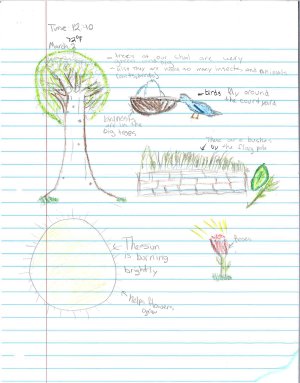Deepening Students’ Connection to Nature
By helping students connect with the outdoors, nature journaling fosters scientific inquiry, literacy, and environmental stewardship.
Children today seem to spend less and less time outdoors, due to the pull of technology, busy family lives, and safety concerns.
Conservationist Richard Louv, author of Last Child in the Woods, discusses the idea that children are experiencing a “nature-deficit disorder” as society becomes less connected to the natural world. Louv has devoted much of his career researching how the move away from nature has affected children and families.
This disconnect has dire consequences for children in the areas of health, communication skills, and academics. And children who spend more time connecting to nature in meaningful ways are more likely to develop pro-environmental attitudes. In order to inspire the next generation of environmental stewards, children need to spend time in and engage with nature.
The use of nature journals gives students a chance to connect with the outdoors, in the hope that this interaction will increase their awareness and appreciation of environmental issues.
What Is a Nature Journal?
A nature journal lies somewhere between a diary and a class notebook. Journals are effective tools for engagement, allowing students to use a personal, expressive style of writing, which they are not often exposed to at school. Nature journals include accurate sketches and notations of scientific observations. Journaling can be modified to use with any age level (including adults).

Journaling in and about nature is a blend of academics and personal experience. The use of nature journals supports student writing, observation, and communication skills. And journals can connect to disciplinary core ideas in the Next Generation Science Standards:
- LS2: Ecosystems: Interactions, Energy, and Dynamics
- LS4: Biological Evolution: Unity and Diversity
- ESS2: Earth’s Systems
- ESS3: Earth and Human Activity
Journals can inspire scientific inquiry if students generate questions about what they’ve observed. The personal connection students create with nature by journaling can also help develop ecological literacy through creative documentation of the natural world as seen through students’ eyes.
Getting Started
Setting up a nature journal is easy. All students need is a notebook, writing tools—pens and/or colored pencils—and an outdoor area, which can be a school garden, playground, home backyard, or forest.
While nature journals evoke the freedom that comes from drawing, there are some guidelines to follow for making a proper entry. An entry should include:
- The date, time, and location
- Weather observations: Temperature can be recorded using a thermometer or a weather app. Students can describe whether the sky is cloudy or sunny, or the day is windy, etc.
- Written observations of things seen, heard, and/or smelled. These can be in complete sentences or short phrases.
- Drawings of plants and animals observed. These can be individual pictures or a full scene. Sketches don’t have to be perfect, but they should try to capture what the plant or animal really looks like.
Have students select a “sit spot”—a site where they can sit for 20 to 30 minutes and make observations. Using the same sit spot repeatedly allows students to make observations about any changes they may see. Or sit spots can be moved, allowing students the chance to see how different spaces are similar to and different from each other.
Nature journaling is most effective when offered as more than a one-time activity. The more students work with their journals, the more comfortable and confident they will become.
Helpful Hints
Have patience: Be patient, and teach your students to be patient with themselves. This can be a new experience for teachers and students. If students are having trouble sitting for a long time at first, start out with shorter increments and build up their stamina for longer periods.
Provide prompts: Trying to record everything they observe can be overwhelming for students. Focus the experience by giving them prompts or investigation questions to answer. What do you see, hear, or smell? Did you observe any plant and animal interactions? How do you think the weather today is affecting our observations?
Let grammar go: The focus of journaling is to get students to observe the natural world and enjoy the activity. If students are worried about perfect spelling and grammar, they won’t produce an authentic product.
Enjoy: Nature journals are meant to be a fun learning experience for everyone.
Teachers as Environmental Facilitators
Environmental education is a lifelong process that begins with childhood experiences in nature. Classroom teachers are among the most important components of environmental education—they act as a connection between education and society as a whole to help students develop positive attitudes about environmental issues.
The use of nature journals can be empowering for students as it helps increase their awareness of nature, gives them a sense of their place in their world, and encourages future conservation behaviors.
